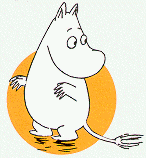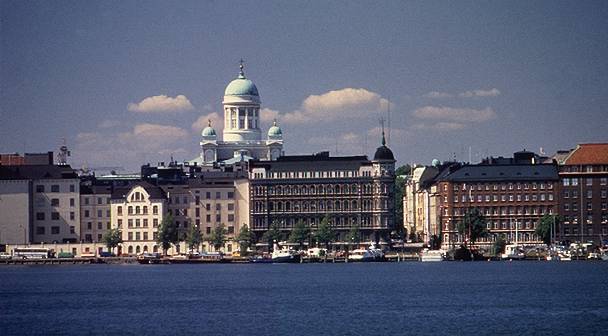 ...Finland
...
...Finland
...
 ...Finland
...
...Finland
...

Finland (Finnish name Suomi) is
a republic which became a member of the European Union in 1995. Its population
is
5.2 million. The capital Helsinki has 555 500 residents. Finland is an
advanced industrial economy: the metal, engineering
and electronics industries account for 50 % of
export revenues, the forest products industry for 30 %. Finland is said
to
be 'the most on-line nation in the world', with
more mobile phones and Internet connections per capita than any other country.
Forests cover three quarters of the country's
surface area of 338 000 sq. km. Other outstanding features of Finland's
scenery are some 190 000 lakes and approximately
as many islands. The principal archipelago and the self governing
province of the Åland Islands lie off the
south-west coast while the main lake district, centered on Lake Saimaa,
is in the east.
~~~~~~~~~~~~~~~~~~~~
Location:
Northern Europe, bordering the Baltic Sea, Gulf
of Bothnia, and Gulf of Finland, between Sweden and Russia
Area: total area: 337,030 sq. km land area: 305,470 sq. km ( comparative area: slightly smaller than Montana)
Land boundaries: total 2,628 km, Norway 729 km, Sweden 586 km, Russia 1,313 km Coastline: 1,126 km (excludes islands and coastal indentations)
Climate:
cold temperate; potentially sub arctic, but comparatively
mild because of moderating influence of the North Atlantic Current,
Baltic Sea, and more than 60,000 lakes
Terrain: mostly low, flat to rolling plains interspersed with lakes and low hills
Natural resources: timber, copper, zinc, iron ore, silver
Population
The population of Finland is approximately 5
200 000. Finland is the sixth largest country in Europe in area, with a
low population density of 17 persons per square kilometer. Most Finns,
some 65 %, now live in urban areas, while 35 % remain in a rural environment.
The three cities of Helsinki, the capital, population 555 500, Espoo,
213 300, and Vantaa, 178 500, from the fast growing Helsinki metropolitan
region, which is now home to roughly sixth of the country's total
population. Other important cities are Tampere, 195 500, Turku, 172 500,
and in the north Oulu, 12, 800.
Environment
current issues:... air pollution from manufacturing
and power plants contributing to acid rain; water pollution from industrial
wastes, agricultural chemicals; habitat loss threatens wildlife populations
international agreements:
party to - Air Pollution, Air Pollution
Nitrogen Oxides, Air Pollution-Sulphur 85, Air Pollution Volatile Organic
Compounds, Antarctic Treaty, Bio diversity, Climate Change, Endangered
Species, Environmental Modification, Hazardous Wastes, Marine Dumping,
Marine Life Conservation, Nuclear Test Ban, Ozone Layer
Protection, Ship Pollution, Tropical Timber 83, Wetlands, Whaling; signed,
but not ratified - Air Pollution-Sulphur 94, Antarctic Environmental Protocol,
Decertification, Law of the Sea
Note: long boundary with Russia; Helsinki is northernmost national capital on European continent; population concentrated on small southwestern coastal plain
Finnish
Ethnic divisions: Finn, Swede, Lapp,
Gypsy, Tatar
Religions: Evangelical Lutheran 89%, Greek
Orthodox 1%, none 9%, other 1%
Languages: Finnish 93.5% (official), Swedish 6.3% (official), small Lapp- and Russian speaking minorities
The Finnish language is a member of the Finno-Ugric linguistic family that includes, in one branch, Finnish, Estonian and a number of other Finnic tongues, and in the other, Hungarian, by far the biggest language of the Ugric group. The official languages of Finland are Finnish and Swedish, the latter spoken as a mother tongue by about 6 % of the people. Another indigenous minority language is Sami, spoken by the Sami people (also known as Lapps) of Lapland. The official status of Swedish has historical roots in the period when Finland was a part of the Swedish realm, a period that lasted from the beginning of the 13th century until 1809.
Education
Schooling is free and compulsory in Finland between
the ages of 7 and 16. Virtually no illiteracy exists. In addition to
regular primary and secondary schools, Finland has an extensive adult education
program consisting of folk high schools, folk academies, and workers' institutes.
The adult education schools are operated privately or by municipalities
or provinces and receive state subsidies.
Culture
After the conquest of the Finnish tribes by Sweden
beginning in the 12th century , the indigenous culture was to a great
extent dominated by Swedish influences, which endure to the present.
Among the peasants, traditional epic poems continued to be
sung to the accompaniment of the zither like
kantele, and wood carvings and rugs were still decorated with the
traditional polychromy and spiral, swastika (an ancient symbol), and similar
simple, geometric designs. Among the educated, however, Swedish
culture predominated. Swedish was spoken and, with rare exceptions, was
the language of literature. Because the styles of Swedish art and
architecture were largely derivative, many Finnish buildings and
works of art reflected Italian, Flemish, German, and other European influences.
In the 19th century, however, educated Finns began to revive the
folk traditions of their country. At the same time, a national literature
in the Finnish language emerged, and Finnish styles appeared
increasingly in art and architecture. The
sauna, a steam bath produced by pouring water over heated rocks, is a Finnish
invention.
Music
Finland possesses a wealth of folk music and
a large body of church music, the former amassed since ancient times and
the latter developed since the acceptance of Christianity by the Finns
in the 12th century. During the Reformation, Gregorian chant and other
existing vocal church music, previously composed to Latin texts, was adapted
to the Finnish language.
The cultivation of secular music began in the 17th century. An amateur orchestra was formed in the former Finnish capital Turku, and in 1640 music was made part of the curriculum of the university at Åbo.
The development of Finnish art music began about the middle of the 19th century, mainly as a result of the works and teaching of two German born musicians, composer Fredrik Pacius and conductor and collector of Finnish folk songs Richard Friedrich Faltin. Martin Wegelius, the first important native born composer, also significantly influenced the development of Finnish art music as director of the Helsinki Conservatory. His contemporary, the Finnish composer Robert Kajanus, introduced Finnish music to Western European audiences as conductor of the Helsinki Municipal Orchestra.
Until the late 19th century the dominant
influence on Finnish composers was that of German music. Pacius, Faltin,
Wegelius,
and Kajanus all cultivated Finnish folk music
in their work, but it was Jean Sibelius, the student of Kajanus, who created
a truly national musical style and won international recognition for Finnish
music.
In December 1993 the new, 1,385-seat Finnish National Opera House opened in Helsinki; it is the home of the Finnish National Opera and the Finnish National Ballet. Finland has produced many operas of distinction in recent years by composers such as Aulis Sallinen, Einojuhani Rautavaara, Erik Bergman, and Joonas Kookonen. After Finland became independent in 1917, modern Finnish composers grew increasingly interested in a variety of modern trends.
New "Music" Group in Finland
... they shout instead of sing... Mieskuoro HUUTAJAT![]()
(Click on the link to find out more)
Folk Lore
"Moomins ", as written by Tove Jansson ( 1914-2001),
appear in book form and now on television click on this link
to learn more...
Tove Jansson ...  .... and a Moomin ...
.... and a Moomin ... 
\
Helsinki is the capital of Finland. Located on
Helsinki Harbor in the Gulf of Finland, it is also a major seaport and
the largest city in the country. In this picture, the Suurkirkko, or
Great Church, rises in the background
Encarta
Some important dates in the history of Finland:
1155-The first missionaries arrive in Finland
from Sweden. Finland becomes part of the Swedish realm.
1809-Sweden surrenders Finland to Russia.
The Czar declares Finland a semi-autonomous Grand Duchy with himself as
constitutional monarch represented by a governor general.
1917-Finland declares independence from
Russia on December 6.
1919-The constitution is adopted and Finland
becomes a republic with a president as head of state.
1939/40-The Soviet Union attacks Finland
and the Winter War is fought.
1941/44-Fighting between Finnish and Soviet
forces resumes in the Continuation War. Some territory is ceded to the
Soviet Union but Finland is never occupied and preserves its independence
and sovereignty.
1955-Finland joins the United Nations
and in 1956 the Nordic Council.
1995-Finland becomes a member of the European
Union.
2000-New constitution of Finland entered
into force on March 1.
information
from
more information
A wonderful book, "Of Finnish Ways" says this about sisu:
"It is not surprising that sisu is a word that can't be translated. No other language has a word which quite conveys the meaning, possibly because no other country has ever had a need of this quality. Sisu refers not to the courage of optimism, but to a concept of life that says, I may not win, but I will give up my life gladly for what I believe...This feeling has sustained the Finns in fighting forty-two wars with Russia and losing every one. It's the quality that lets them laugh at themselves in the face of disaster. It's the hard-jawed integrity that made them pay their war debts when wealthier nations repudiated their obligations. In short, it's the indomitable will that sets Finns apart and explains many of the incredible things they do. Sisu is the only word for the Finn's strongest nationalcharacteristic."
Put another way, by a person of Finnish descent, "Sisu is the ability to hold onto the end of the rope, while dangling over a precipice, for 5 seconds longer than you thought you could. Then going 5 more hours..."